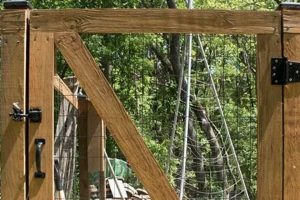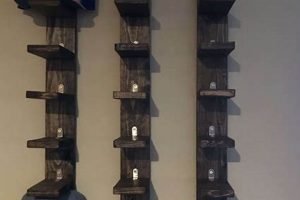A self-assembled, wall-mounted planting structure offers an alternative approach to traditional gardening. Constructed from various materials like repurposed pallets, plastic bottles, or modular kits, these structures allow for the cultivation of plants in a compact, vertical space. For instance, herbs can be grown on a kitchen wall using a system of stacked planters, maximizing sunlight exposure in a limited area.
This method of cultivation provides several advantages, particularly in urban environments where space is a premium. It enhances aesthetic appeal, improves air quality through plant transpiration, and can even provide a source of fresh produce. Historically, vertical gardening practices can be traced back to ancient civilizations, demonstrating a long-standing human interest in optimizing plant growth in constrained spaces.
Subsequent sections will delve into practical aspects of constructing these systems, including material selection, plant choices suitable for vertical growth, irrigation techniques, and essential maintenance strategies required to ensure the longevity and health of a planted wall. Specific challenges and solutions related to lighting, drainage, and pest control will also be addressed.
Practical Guidance for Vertical Planting Systems
Successfully implementing a vertical planting system requires careful consideration of several key factors. The following guidance outlines essential steps to optimize growth and longevity of the arrangement.
Tip 1: Structural Integrity Assessment: Prior to construction, evaluate the load-bearing capacity of the intended mounting surface. The weight of saturated soil and mature plants can be substantial; reinforce the structure if necessary to prevent collapse.
Tip 2: Optimal Plant Selection: Choose plant species appropriate for the local climate and available sunlight. Consider factors such as growth habit (trailing vs. upright), water requirements, and susceptibility to common pests and diseases.
Tip 3: Efficient Irrigation Design: Implement a consistent watering strategy. Drip irrigation systems are often preferred to minimize water waste and ensure uniform moisture distribution. Consider a timer for automated watering schedules.
Tip 4: Adequate Drainage Provision: Ensure adequate drainage within the planting structure to prevent root rot. Incorporate drainage layers using gravel or perlite to facilitate water flow.
Tip 5: Soil Composition Optimization: Utilize a well-draining soil mix specifically formulated for container gardening. Amend the soil with organic matter such as compost to improve fertility and water retention.
Tip 6: Regular Fertilization Schedule: Provide supplemental nutrients through regular fertilization. Use a balanced fertilizer appropriate for the selected plant species, following the manufacturer’s recommendations.
Tip 7: Pest and Disease Management: Implement proactive pest and disease management strategies. Regularly inspect plants for signs of infestation or disease, and treat promptly with appropriate organic or chemical controls.
Tip 8: Sunlight Exposure Evaluation: Assess the amount of sunlight the vertical planting system receives throughout the day. Supplement with artificial lighting if necessary to ensure adequate photosynthetic activity, especially in shaded areas.
Adhering to these guidelines contributes significantly to the overall health and productivity of a vertical planting arrangement, promoting sustainable and aesthetically pleasing green spaces.
The concluding section will discuss long-term maintenance and adaptation strategies for these systems, ensuring continued success and environmental benefits.
1. Space Optimization in Vertical Gardening
Space optimization is a critical consideration in the design and implementation of self-assembled, wall-mounted planting structures. The inherent limitations of urban environments, coupled with a growing interest in sustainable practices, necessitate innovative approaches to maximize plant cultivation within minimal footprints.
- Vertical Expansion
Vertical gardening directly addresses space constraints by expanding gardening possibilities upward rather than outward. This allows for the cultivation of a diverse range of plants, including herbs, vegetables, and ornamentals, in areas with limited horizontal space. A small balcony, for instance, can be transformed into a productive garden through the strategic placement of vertically oriented planters.
- Surface Area Maximization
Effective space optimization involves maximizing the available surface area for plant growth. This can be achieved through various structural designs, such as tiered planters, stacked containers, or modular systems that utilize every available inch of vertical space. By increasing the planting surface, more plants can be accommodated within the same spatial volume.
- Efficient Resource Utilization
Optimizing space also contributes to efficient resource utilization. A well-designed vertical garden minimizes water waste by directing irrigation to specific planting areas. Furthermore, strategic plant placement can optimize sunlight exposure, ensuring that each plant receives adequate light for photosynthesis. This approach reduces the need for supplemental resources and promotes sustainable growth.
- Aesthetic and Functional Integration
Beyond purely horticultural considerations, space optimization also facilitates the integration of gardens into living spaces. Vertical gardens can serve as architectural features, enhancing the aesthetic appeal of walls, balconies, or patios. Moreover, they can provide functional benefits, such as privacy screens or natural air purifiers, further maximizing the utility of limited spaces.
The principles of space optimization are integral to the success of DIY vertical gardening. By carefully considering factors such as structural design, plant selection, and resource management, it is possible to create productive and visually appealing green spaces in even the most constrained urban environments. These optimized systems offer a practical and sustainable solution for individuals seeking to enhance their living spaces and engage in urban agriculture.
2. Material Selection
Material selection constitutes a critical decision-making process in the development of a self-assembled, wall-mounted planting structure, influencing longevity, functionality, and aesthetic appeal. The materials employed directly impact the garden’s structural integrity, resistance to environmental factors, and suitability for the intended plant species. Inadequate material choices can lead to premature structural failure, water damage, or even t
oxicity to the plants. For instance, using untreated wood in a high-moisture environment can result in rapid decomposition, necessitating frequent repairs or replacement. Conversely, selecting durable, weather-resistant materials such as treated lumber, recycled plastics, or powder-coated metal significantly extends the lifespan of the vertical garden. Improper material selection can detrimentally affect the health of the plants, jeopardizing the success of the entire gardening endeavor.
Different materials offer unique advantages and disadvantages. Recycled plastic bottles, for example, offer a cost-effective and environmentally conscious option for creating individual planting containers. However, their limited structural strength may necessitate additional support frameworks. Pallet wood, while readily available and aesthetically rustic, requires careful inspection to ensure it has not been treated with harmful chemicals. Modular systems constructed from metal or composite materials provide enhanced durability and design flexibility but often entail a higher initial investment. The permeability and thermal properties of selected materials also affect root zone temperature and moisture retention, influencing plant health. The use of dark-colored plastics, for instance, can cause overheating in direct sunlight, potentially damaging root systems. Careful consideration of these factors allows for the construction of a vertical garden that is both aesthetically pleasing and functionally effective.
In summary, material selection is not merely an aesthetic consideration but a fundamental determinant of the success and sustainability of a self-assembled, wall-mounted planting structure. Choices related to material influence structural integrity, environmental resistance, plant health, and overall longevity of the system. Prioritizing informed material selection based on specific environmental conditions, plant requirements, and budgetary constraints is essential for achieving a thriving and sustainable vertical garden.
3. Irrigation Efficiency
Irrigation efficiency is a critical determinant in the success and sustainability of self-assembled, wall-mounted planting structures. Due to their elevated and often exposed nature, vertical gardens are particularly susceptible to water loss through evaporation and drainage, necessitating carefully designed and implemented irrigation strategies.
- Water Conservation Techniques
Efficient irrigation minimizes water consumption in vertical gardens through the implementation of targeted delivery systems. Drip irrigation, for instance, delivers water directly to the root zone, reducing water loss due to evaporation or runoff. Soaker hoses and micro-sprinklers are also effective in distributing water evenly while conserving water resources. Proper utilization of these techniques reduces the environmental impact and operational costs associated with maintaining these gardens.
- Automated Systems
Automated irrigation systems utilize timers and sensors to regulate water delivery based on plant needs and environmental conditions. These systems can be programmed to deliver water at specific times or in response to changes in soil moisture levels. Automation optimizes water use and reduces the potential for over- or under-watering, which are common issues in manual irrigation systems. The initial investment in automated systems often yields long-term savings in water usage and plant health.
- Water Retention Strategies
Improving water retention within the planting medium is crucial for minimizing irrigation frequency. Incorporating materials such as vermiculite, perlite, or coconut coir into the soil mix enhances its water-holding capacity. Mulching the surface of the planters also reduces evaporation and helps maintain consistent soil moisture levels. These water retention strategies decrease the demand on irrigation systems and promote healthier root development.
- Greywater Utilization
The utilization of greywater, which is gently used household wastewater from sources such as showers and sinks, offers a sustainable alternative to potable water for irrigation. Greywater systems require careful filtration and treatment to remove contaminants, ensuring that the water is safe for plant use. Implementing greywater irrigation reduces the reliance on freshwater resources and promotes responsible water management practices. Regulatory compliance and proper system maintenance are essential for safe and effective greywater utilization.
The adoption of efficient irrigation practices is essential for the long-term viability of DIY vertical gardens. Combining water conservation techniques, automated systems, water retention strategies, and alternative water sources like greywater contributes to sustainable resource management and promotes the health and productivity of vertical planting systems. Through careful planning and implementation, irrigation efficiency maximizes the benefits of self-assembled, wall-mounted planting structures while minimizing their environmental footprint.
4. Plant Compatibility
The principle of plant compatibility constitutes a foundational element in the successful implementation of self-assembled, wall-mounted planting structures. In the confined environment of a vertical garden, plant species interact directly, competing for resources such as light, water, and nutrients. Incompatible combinations can lead to suppressed growth, increased susceptibility to pests and diseases, and ultimately, the failure of the system. For example, planting a fast-growing, light-demanding vine alongside a shade-tolerant herb will invariably result in the vine overshadowing and starving the herb of essential light, hindering its development. Conversely, compatible pairings enhance resource utilization, promote biodiversity, and contribute to a more resilient and aesthetically pleasing garden.
Understanding plant compatibility extends beyond simple competition for resources. Allelopathy, the production of biochemicals by one plant that influence the growth of neighboring plants, plays a significant role. Certain species release compounds that inhibit the germination or growth of others, while others can have beneficial effects. For instance, marigolds are often planted alongside tomatoes to deter nematodes, a common soil pest. Similarly, basil is known to improve the growth and flavor of tomatoes. Careful consideration of such interactions allows for the creation of synergistic plant communities that thrive in the constrained vertical space. Factors such as growth habit (upright, trailing, spreading), water requirements (high, medium, low), and nutrient needs (heavy feeders, light feeders) must be meticulously analyzed to ensure a harmonious balance within the system. This approach minimizes resource competition and maximizes the overall health and productivity of the vertical garden.
In conclusion, plant compatibility is not merely a desirable attribute but a critical requirement for a thriving self-assembled, wall-mounted planting structure. A thorough understanding of plant interactions, resource requirements, and allelopathic effects is essential for creating sustainable and aesthetically pleasing vertical gardens. Prioritizing compatible plant pairings minimizes competition, promotes biodiversity, and enhances the long-term health and productivity of the system, solidifying its r
ole as an innovative and sustainable approach to urban gardening.
5. Structural Integrity
The success of a self-assembled, wall-mounted planting structure is inextricably linked to its structural integrity. This encompasses the capacity of the entire system to withstand imposed loads, environmental stressors, and the cumulative weight of growing media, plants, and water over an extended period. A failure to adequately address structural integrity can result in catastrophic collapse, posing significant safety risks and financial losses. For instance, a vertical garden constructed using insufficiently robust materials or inadequate attachment methods may buckle under the weight of saturated soil and mature plants, leading to structural failure and potential injury to individuals in the vicinity.
The materials used in construction, the design of the supporting framework, and the method of attachment to the wall are all critical components that determine structural integrity. Employing pressure-treated lumber, reinforced plastics, or welded metal frames provides a solid foundation capable of supporting substantial weight. Utilizing appropriate fasteners, such as heavy-duty screws or bolts, and ensuring secure anchoring to load-bearing walls are essential for distributing the load evenly and preventing localized stress concentrations. The design should account for dynamic loads, such as wind or seismic activity, and incorporate features to mitigate their impact. Furthermore, the long-term effects of moisture exposure, temperature fluctuations, and ultraviolet radiation must be considered to prevent material degradation and maintain structural stability. Neglecting these considerations increases the risk of component failure and ultimately compromises the entire vertical gardening system.
In summation, structural integrity constitutes a non-negotiable requirement for self-assembled, wall-mounted planting structures. Diligent planning, careful material selection, and meticulous construction techniques are paramount to ensuring the safety, longevity, and overall success of the project. A robust and structurally sound design provides the foundation for a thriving vertical garden, safeguarding against potential hazards and maximizing its aesthetic and functional benefits. Prioritizing structural integrity mitigates risks and contributes to the sustainable integration of vertical gardening into urban environments.
6. Sunlight Exposure
Sunlight exposure is a fundamental determinant of the success of any self-assembled, wall-mounted planting structure. Adequate light levels are essential for photosynthesis, the process by which plants convert light energy into chemical energy for growth and development. The specific light requirements vary significantly across plant species, necessitating careful consideration of sunlight availability during the planning and implementation phases of a vertical garden project.
- Orientation and Placement
The orientation of the wall and the placement of the structure significantly impact the amount of sunlight received. South-facing walls in the Northern Hemisphere typically receive the most direct sunlight throughout the day, making them ideal for sun-loving plants. East- and west-facing walls receive moderate sunlight, while north-facing walls receive the least, requiring shade-tolerant species. Careful selection of a location that aligns with the light requirements of the chosen plants is essential for optimal growth. For example, herbs like basil and rosemary thrive on south-facing walls, while ferns and hostas are better suited for north-facing locations.
- Shading and Reflection
Existing structures, such as buildings or trees, can create shading patterns that affect sunlight exposure. The angle of the sun changes throughout the year, altering the extent and duration of shade. Conversely, reflective surfaces, such as light-colored walls or bodies of water, can amplify sunlight exposure. Understanding these factors is critical for predicting light availability and selecting appropriate plant species. A vertical garden placed near a white wall may receive more intense sunlight than one placed against a dark wall, requiring adjustments in plant selection or shading strategies.
- Supplemental Lighting
In situations where natural sunlight is insufficient, supplemental lighting can be used to provide the necessary light energy for plant growth. Grow lights, which emit specific wavelengths of light that plants utilize for photosynthesis, can be strategically positioned to supplement natural sunlight. This is particularly useful for indoor vertical gardens or those located in areas with limited sunlight. Selecting the appropriate type and intensity of grow lights is crucial for maximizing their effectiveness and minimizing energy consumption. LED grow lights are often preferred due to their energy efficiency and customizable light spectrum.
- Plant Arrangement and Density
The arrangement and density of plants within the vertical garden affect light penetration. Taller plants can cast shadows on shorter plants, reducing their access to sunlight. Proper spacing and strategic placement of plants based on their light requirements can help ensure that all plants receive adequate light. Regular pruning and thinning may also be necessary to prevent overcrowding and maximize light penetration. Arranging plants in tiers, with taller plants at the top and shorter plants at the bottom, can optimize light distribution within the system.
In conclusion, sunlight exposure is a critical factor influencing the health and productivity of self-assembled, wall-mounted planting structures. By carefully considering orientation, shading, reflection, supplemental lighting, and plant arrangement, it is possible to optimize light availability and create thriving vertical gardens in a variety of environments. Prioritizing sunlight exposure as a key design element enhances the success and sustainability of these innovative urban gardening systems.
7. Maintenance Ease
Maintenance ease is a crucial consideration in the design and adoption of self-assembled, wall-mounted planting structures. The long-term viability and aesthetic appeal of these installations hinge on their ease of upkeep, influencing both their initial construction and subsequent operational demands.
- Accessibility for Upkeep
The design of a vertical garden should prioritize accessibility for routine tasks such as watering, fertilization, pruning, and pest control. Systems that are difficult to reach or disassemble for maintenance often lead to neglect and eventual decline. Modular designs, with easily removable planters or components, can significantly improve accessibility. For example, individual planters that can be detached and brought to ground level for maintenance streamline upkeep.
- Automated Systems Integration
The integration of automated systems, such as timed irrigation and fertilization, can substantially reduce the manual labor required for maintaining a vertical garden. These systems ensure consistent and optimal resource delivery, miti
gating the risk of plant stress due to inconsistent care. A drip irrigation system controlled by a timer, for example, can automatically water the plants according to a pre-set schedule, minimizing the need for manual watering. - Material Selection and Longevity
The choice of durable, low-maintenance materials is paramount in ensuring long-term maintenance ease. Materials resistant to rot, corrosion, and UV degradation reduce the need for frequent repairs and replacements. Recycled plastics or treated woods, for instance, offer superior durability compared to untreated materials, minimizing the need for structural maintenance over time.
- Pest and Disease Resistance
Selecting plant species that exhibit inherent resistance to common pests and diseases reduces the need for intensive pest control measures. Native plants or cultivars known for their resilience often require less intervention than more susceptible varieties. Companion planting, where certain plant species are strategically placed to deter pests or diseases, can further reduce the need for chemical treatments, simplifying maintenance routines.
Maintenance ease is not merely a convenience but a fundamental requirement for the sustainable integration of self-assembled, wall-mounted planting structures into urban environments. By prioritizing accessibility, automating routine tasks, selecting durable materials, and focusing on pest and disease resistance, the long-term viability and aesthetic appeal of vertical gardens can be significantly enhanced, promoting their widespread adoption and contributing to greener urban spaces.
Frequently Asked Questions
The following section addresses common inquiries regarding the construction, maintenance, and viability of self-assembled, wall-mounted planting structures. The information provided aims to offer clear and concise guidance for successful implementation.
Question 1: What are the primary considerations when selecting a location for a DIY vertical garden?
Sunlight exposure, accessibility to water sources, and the structural integrity of the mounting surface are paramount. The selected location should receive adequate sunlight for the intended plant species, allow for convenient irrigation, and possess the load-bearing capacity to support the weight of the saturated planting system.
Question 2: What materials are suitable for constructing a DIY vertical garden frame?
Weather-resistant materials such as treated lumber, recycled plastics, or powder-coated metal are recommended. The material should be durable, non-toxic, and capable of withstanding environmental stressors such as moisture, temperature fluctuations, and ultraviolet radiation.
Question 3: How should irrigation be managed in a DIY vertical garden?
Drip irrigation systems or soaker hoses are effective for delivering water directly to the root zone, minimizing water waste. Automated timers can regulate water delivery based on plant needs and environmental conditions. Ensure adequate drainage to prevent root rot.
Question 4: Which plant species are best suited for DIY vertical gardens?
Plant selection should consider local climate, sunlight availability, and growth habits. Herbs, succulents, and leafy greens are often well-suited due to their compact size and relatively low maintenance requirements. Consider plant compatibility to minimize competition for resources.
Question 5: How is proper drainage ensured in a DIY vertical garden?
Incorporate a drainage layer at the bottom of each planting container using gravel or perlite. Utilize well-draining soil mixes formulated for container gardening. Ensure that each container has drainage holes to allow excess water to escape.
Question 6: What are the common challenges associated with DIY vertical gardens, and how can they be addressed?
Common challenges include inadequate sunlight, pest infestations, and structural instability. These can be addressed by selecting appropriate plant species, implementing pest control measures, and ensuring robust structural support for the system.
In summary, successful creation of a DIY vertical garden hinges on careful planning, appropriate material selection, efficient irrigation, and ongoing maintenance. Adhering to these principles will optimize the system’s performance and longevity.
The subsequent section will provide a comprehensive checklist for constructing a DIY vertical garden, guiding users through each stage of the process.
Concluding Remarks
This exploration has elucidated the critical factors governing the successful design, construction, and maintenance of a DIY vertical garden. From meticulous material selection and the imperative of structural integrity to the optimization of sunlight exposure and irrigation efficiency, a holistic understanding of these interconnected elements is paramount. Furthermore, the careful consideration of plant compatibility and the implementation of proactive maintenance strategies are essential for ensuring the long-term viability and aesthetic appeal of these innovative systems.
The information presented herein should serve as a foundational resource for individuals seeking to integrate sustainable and aesthetically pleasing green spaces into urban environments. The potential benefits of DIY vertical garden extend beyond mere aesthetic enhancement, offering opportunities for urban agriculture, improved air quality, and enhanced biodiversity. A continued dedication to best practices will facilitate the creation of thriving vertical ecosystems, contributing to more sustainable and resilient urban landscapes.







